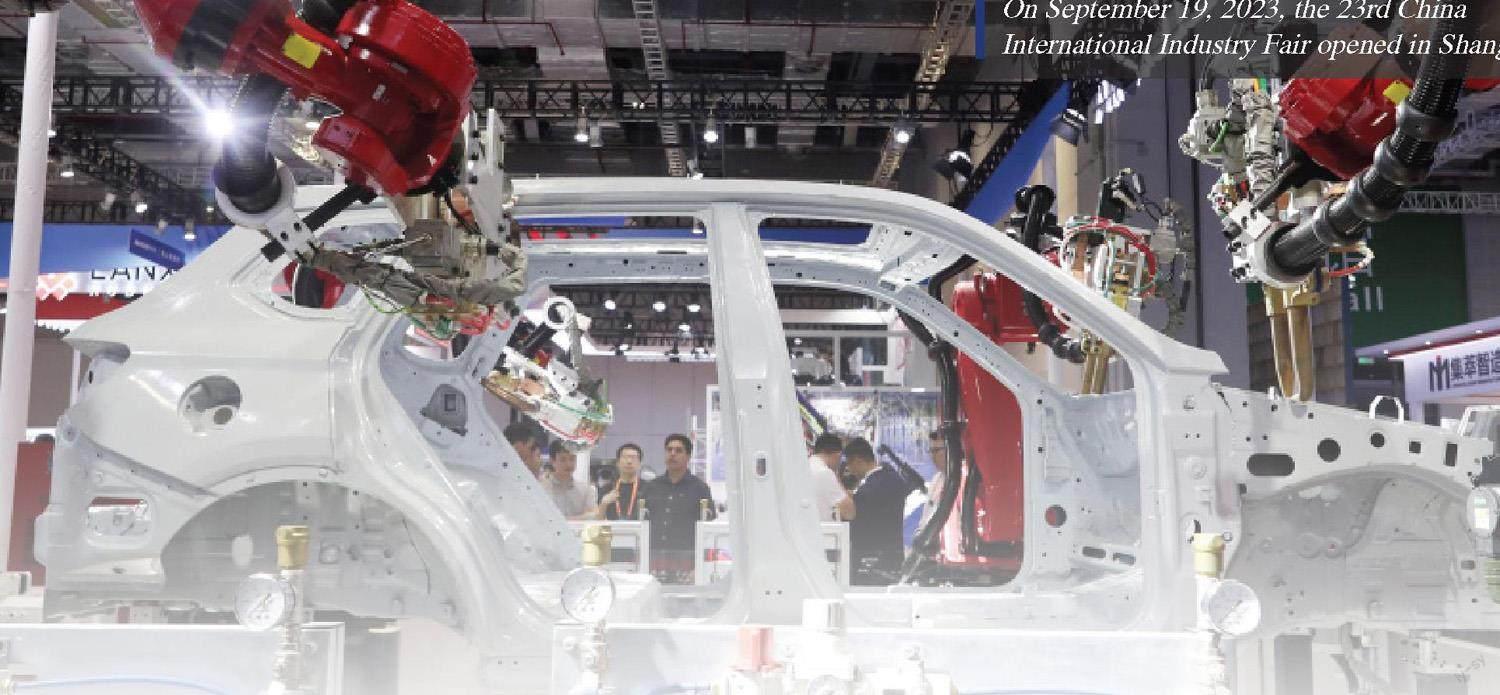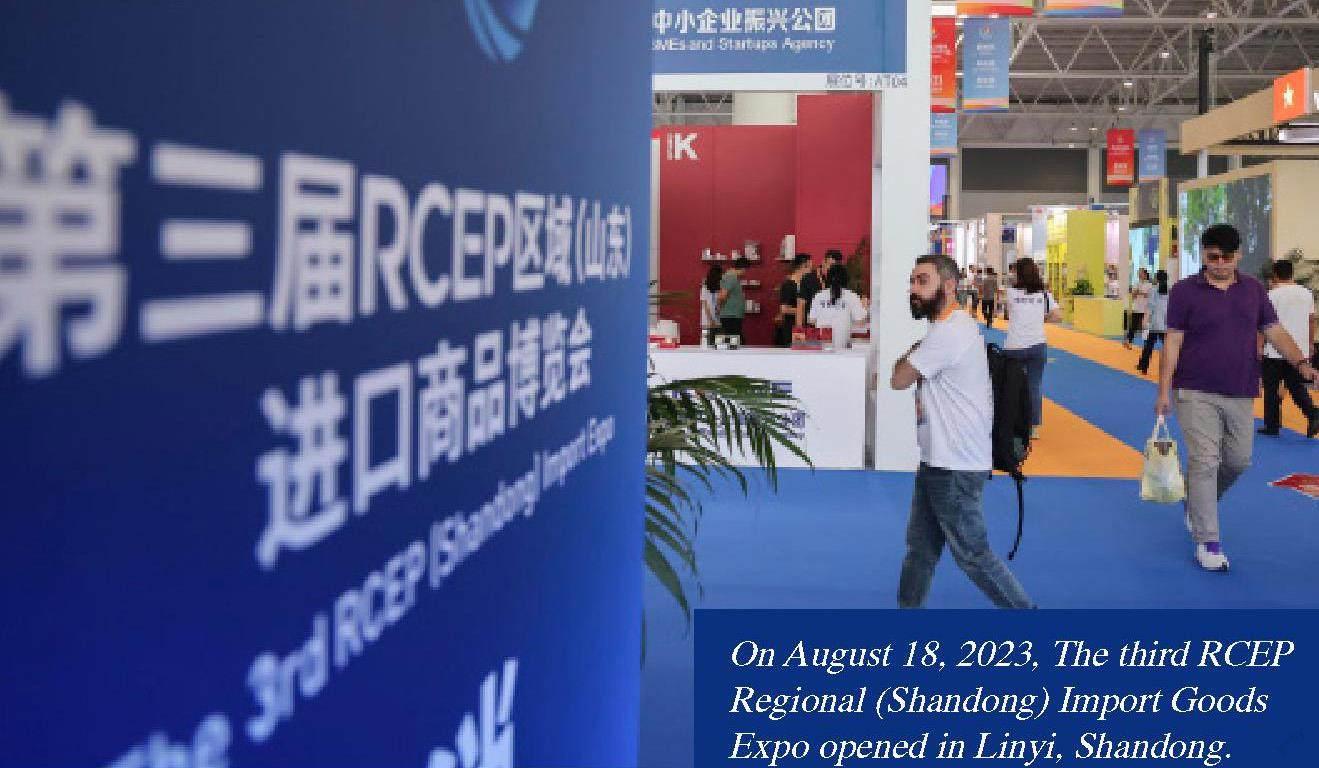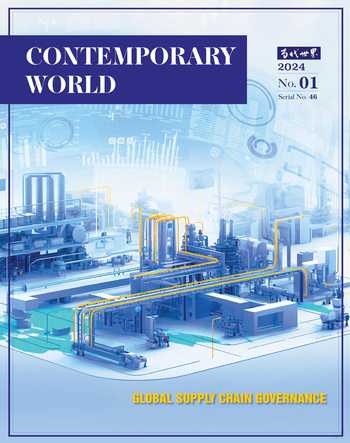International Supply Chain Cooperation and China’s Role
Su Qingyi


In recent years, the challenges facing the development of international supply chains have been increasing. Major country competition, COVID pandemic and geopolitical conflicts have impacted the development of international supply chains and continue to have negative effects. Against this background, the international community should cooperate to deal with the risks and challenges.
International Supply Chain Development Faces Four Major Challenges
The international supply chain is a mode of division of labor in which all countries contribute to the production of a product. Since the 1980s, especially after the end of the Cold War, the international supply chain has experienced a golden age of rapid development, and the degree of division of labor has been deepening. However, the international supply chain is now facing four major challenges, such as limited development potential, the rise of trade protectionism and anti-globalization headwinds, the increasingly intense competition among major countries, and the increase in objective shocks.
Firstly, multiple factors have led to the bottleneck in the development of international supply chains. From the perspective of international trade, international supply chain is a mode of division of labor. The international division of labor refers to the division of production across national boundaries among countries (regions) in the world, which is affected by factors such as the distribution of production factors, the level of scientific and technological development and the international political and economic order. At present, inter-industry, intra-industry and intra-product division of labor are the three main forms of international division of labor, in which intra-product division of labor (international supply chain) occupies a dominant position.
Between the late 1980s and the early 1990s, advances in information technology, declining international transportation costs and institutional changes reduced the costs of cross-border economic activities and accelerated the deepening of the intra-product division of labor. Especially in the early 1990s, against the backdrop of the collapse of the Soviet Union and the dramatic changes in Eastern Europe, Chinas reform and opening-up continued, breaking down the economic and trade restrictions between the East and West camps, and the volume of foreign trade has been on the rise. The scope and proportion of intra-product division of labor is getting wider and wider, and its increase is much higher than that of inter-industry division of labor and intra-industry division of labor.
At present, the development of international supply chain has entered a bottleneck, and the proportion of trade in international supply chain in the total global trade in goods can hardly break through 50%. After the international financial crisis in 2008, the development of the breadth and depth of countries participation in the international supply chain, and the length of international supply chain has stagnated. The development of international supply chains and the tapping of their potential need to be supported by fundamental factors such as reducing trade costs and technological transformation. It is difficult to further deepen the division of labor in international supply chains without new trade liberalization and technological transformation. As a result, the growth of global trade in goods has also experienced a relative downturn, and its share of world GDP is difficult to exceed 30%.
Secondly, the rise of trade protectionism and anti-globalization headwinds has disrupted the stability of the international supply chain. In recent years, trade protectionism and anti-globalization have been on the rise, spreading from the private to the governmental level in developed countries such as the U.S. and European countries. Globally, an average of 223 new trade and investment restrictive measures have been added each year, and only 61 new trade and investment liberalization measures have been added. Among them, the U.S. has introduced significantly more trade and investment restrictive measures than other countries, accounting for 7.43% of all restrictive measures. Especially during Trumps presidency of the U.S., the countrys protectionism has become more and more serious. In February 2018, the U.S. imposed tariffs of 30% and 50% on imports of solar panels and washing machines, respectively, based on the “201 investigation”. In March, based on the “232 investigation”, the U.S. imposed tariffs on steel, aluminum of 25% and 10% respectively. It even launched a “trade war” against China based on the “301 investigation”. And since 2017, the U.S. has revised and implemented the Foreign Investment Risk Review Modernization Act to strengthen the review of foreign investment in the U.S.. The Biden administration has not changed the relevant trade policies of the Trump administration since it came to power.
Thirdly, the major country competition and geopolitical conflicts hinder the development of international supply chains. With Chinas economic strength getting closer and closer to the U.S., the U.S. strategic anxiety has increased. And the comprehensive containment and suppression of China has seriously undermined the healthy and stable development of the international supply chain. The major country competition mainly affects the development of international supply chains in four dimensions:
First, the adjustment of U.S. international economic policies has affected the development of international supply chains. The so-called “de-risking” promoted by the U.S. and the boosting of trade modes such as “friendly-shoring”, “near-shoring” and “reshoring” have caused the contraction of international supply chains. Second, the export control policy of the U.S. has undermined the division of labor in the international supply chain. In the name of maintaining national security, the U.S. has implemented the policy of “small yard and high fence”, and has continuously strengthened its export control on high-tech products to China, which has brought great damage to the international supply chain of high-tech industries, such as semiconductors, and negatively affected the supply chain of other industries. Third, the U.S. imposed tariffs on China to increase trade costs. A large number of tariffs imposed by the U.S. on China through the “301 investigation” have not been canceled so far, seriously impacting the market operating environment for the development of the international supply chain, and forcing some multinational enterprises in China to transfer part of their industries to Vietnam, India, Mexico and other countries with higher comprehensive costs. Fourth, the Sino-U.S. relations and geopolitical uncertainty increase the risk of enterprise production and operation. The uncertainty of the development of the relationship between major countries also makes many enterprises have to diversify the configuration in the production and operation process, which affects the operational efficiency of the international supply chain.
Fourthly, the international supply chain is facing an increase in objective shocks, and the international community is not sufficiently motivated to cooperate and respond to them. Natural disasters, transportation disruptions, cyber-attacks, power supply constraints, labor shortages, etc. will all impact international supply chains. A report released by the McKinsey Global Institute points out that, on average, supply chain disruptions lasting one month or more occur every 3.7 years. Taking six countries of the U.S., China, Japan, South Korea, Italy, Germany as examples, these countries accounted for 55% of the global GDP, 60% of the total global manufacturing production, 50% of the total global manufacturing exports. Serious impact of the COVID pandemic are imposed to them to varying degrees not only on their economy, but also on the international supply chain. Specifically, the epidemic has affected the international supply chain in terms of supply, demand, freight transportation and movement of people, and the more industries in the chain, the greater the impact, such as electronics and automobiles, etc. The pandemic has also forced countries to readjust their international supply chain development model and minimize their reliance on external supply chains to reduce risks. In the future, objective shocks such as the pandemic will continue to exist, which is a major challenge that international supply chain development has to face.
The International Community Needs to Cooperate to Meet Supply Chain Challenges
Meeting the international supply chain challenges requires collective action. Only when all chains develop well will the supply chain as a whole develop stably. Facing up to the four major challenges to the international supply chain, countries should strengthen cooperation and take targeted measures.
Firstly, countries should enhance the development potential of international supply chains by actively promoting trade liberalization and seizing new opportunities brought about by technological changes. The international supply chain is characterized by the fact that all countries produce in their most efficient links, thus making the price of the final product lower. At the same time, the more a product crosses national borders in the production process, the higher the trade costs. In contrast to the traditional mode of production in a single country, the development potential of international supply chains depends on the trade-off between the incentive to reduce production costs and the resistance to increase trade costs. Therefore, there is a need to reduce trade costs as an important tool to enhance the development potential of international supply chains. There are two ways to reduce trade costs: first, by eliminating barriers to trade in goods through multilateral or regional trade liberalization, and second, by promoting technological transformation to reduce the cost of goods across borders.
Secondly, major countries should reduce their impact on international supply chains by responsibly managing competition among themselves. National competition has negative externalities. In an international supply chain, sanctions imposed by one country on another can affect the entire chain, which in turn ripples through to third parties in the chain. The U.S., as the worlds largest economy, should be mindful of the spillover of national competition. Disruptions in the supply chain caused by a governments restrictions on corporate exports could potentially lead to damage to the interests of multiple countries. Therefore, markets should be allowed to play a role in international supply chains, and an open supply chain is in the interest of all countries. The golden age of international supply chain development has proved that market forces are the most fundamental force driving supply chain development, and supply chain security challenges brought about by national competition or even confrontation should be kept within certain limits. The supply chain risks posed to businesses by markets and COVID pandemic need to be eliminated through cooperation between countries. Confrontation is the worst-case scenario, slowing down or even reversing the development of international supply chains.
Thirdly, the international community should work together to deal with objective shocks to international supply chains. The so-called de-risking cannot achieve the purpose of reducing supply chain risks and ensuring supply chain stability. The U.S. tries to achieve the purpose of maintaining security by establishing a supply chain that excludes China, but it wrongly believes that security means de-risking, that is, decoupling and breaking the chain with China. The U.S. does face supply chain risks, but it is difficult for other countries to challenge U.S. supply chain security. The exclusion of China makes diversification difficult and increases supply chain vulnerability, and in turn increases supply chain risk. The EU, Japan, ASEAN and others should not be kidnapped by the U.S. supply chain security strategy, and their optimal choice is to work together to formulate international rules, and to reduce risks through cooperation.
China Actively Promotes Cooperation on International Supply Chain
As the worlds largest goods trading country and an important participant in the international supply chain, China has always been determined to maintain the stability of the international supply chain and promote the development of the international supply chain. The first China International Supply Chain Expo was held in Beijing from November 28 to December 2, 2023, which embodies Chinas commitment to maintaining the stability and smooth flow of the industrial chain and supply chain as a big country.
Firstly, it endeavors to create a favorable environment for international supply chain development by actively building an open world economy. China steadfastly opposes trade protectionism, building walls and barriers, decoupling and breaking chains, unilateral sanctions, extreme pressure and other behaviors that hinder the progress of globalization. It has always been an active promoter of the correct direction of economic globalization, and has continuously provided new opportunities for the world with Chinas new development, so that opening up can provide a good environment for the global supply chain. China has always insisted on promoting the implementation of the Global Development Initiative, the Global Security Initiative and the Global Civilization Initiative, emphasizing that peaceful and cooperative development become the main theme of the whole world, and common security should become the consensus of all countries. China will promote the high-quality development under the Belt and Road Initiative, and make the Belt and Road construction an important platform for cooperation among countries. China actively participates in the reform and creation of the global governance system, pushes forward the internationalization of RMB in an orderly manner, and supports the World Trade Organization and other multilateral mechanisms to play a better role. These actions of China have undoubtedly created a favorable environment for supply chain development.
Secondly, it endeavors to reduce the uncertainty of international supply chain development by proactively controlling the competition among big countries. President Xi Jinping pointed out that the essence of China-U.S. economic and trade relations is mutual benefit. One should make a bigger “cake” of cooperation. The U.S. should stop abusing and generalizing national security concepts to suppress Chinese enterprises. China has always insisted on responding to the “trade war” initiated by the U.S. in a reasonable and justified manner and properly handling the economic and trade friction between China and the U.S. in a constructive manner. On the one hand, China is committed to bilateral consultations with the U.S. to resolve trade disputes through negotiation, reduce the negative impact of the “trade war” on each other, and ultimately reach a mutually beneficial and win-win agreement. On the other hand, China has also demonstrated its firm attitude to safeguard its own national interests, i.e., if the U.S. insists on imposing tariffs on Chinese products, China will resolutely counteract and at the same time sue the U.S. for its actions to the World Trade Organizations Dispute Settlement Body. China has always believed that dialogue, not confrontation, is the only way to resolve relevant economic and trade differences. The China-U.S. Phase-one Economic and Trade Agreement proves that differences between China and the U.S. in economic and trade matters cannot be resolved through unilateral “tariff wars”, but only through negotiation. Chinas initiative to control the competition among major countries will help reduce the uncertainty of supply chain operations.
Thirdly, it endeavors to advocate that the international community should strengthen cooperation to withstand the various types of shocks faced by the international supply chain. Under the premise of consensus rules, it is less likely that the World Trade Organization will make rules multilaterally, and in the future it will promote rule-making through plurilateral negotiations. China has launched an investment facilitation initiative and actively participated in plurilateral negotiations on domestic regulation of trade in services and E-commerce, creating a good institutional guarantee for supply chain development. China was also working with other members to maintain the security of key industrial chains such as medical supplies and food under the framework of the World Trade Organization.
In addition to actively improving its relations with the U.S., China also coordinates its relations with major economies such as the EU, ASEAN, Japan, India and Brazil. China has always taken on open attitude to the relaunch of the China–EU comprehensive Agreement on Investment, and has actively strengthened economic and trade relations with ASEAN to stabilize the East Asian regional industrial chain. As for Japan, in addition to developing and strengthening China-Japan economic and trade relations under the RCEP framework, China hopes to continue to strengthen economic and trade ties with Japan through joining the CPTPP. In addition, China has fully utilized the BRICS cooperation mechanism to strengthen coordination with emerging economies such as Russia, India, Brazil and South Africa. These actions by China will undoubtedly strengthen the cohesion of the international community against supply chain shocks.
——————————————
Su Qingyi is Researcher of the Institute of World Economics and Politics at the Chinese Academy of Social Sciences
- 當(dāng)代世界英文版的其它文章
- Chinese-Style Modernization is the Path to Peaceful Development
- A Guiding Beacon for a Perplexed World and A Lasting Power for Improving Quality and Growth
- Global Industrial and Supply Chain Restructuring: Background, Characteristics and Development Trends
- Global Supply Chain Governance and the Future of Globalization
- Connecting the World for a Shared Future: Firmly Safeguarding Stable and Smooth Global Industrial and Supply Chains
- The Rise and Impacts of Kenya’s Hustler Movement

